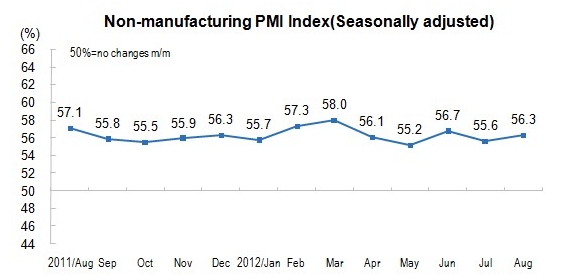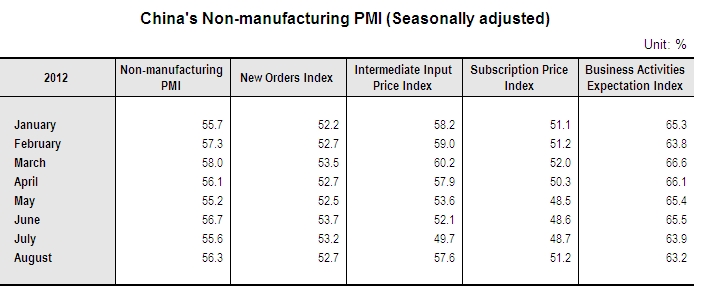In August, non-manufacturing purchasing manager index was 56.3 percent, 0.7 percentage points higher than that in the previous month, still staying above the threshold.
In view of different industries, the purchasing manager index of construction was 61.1 percent, 0.7 percentage points higher than that in the previous month, still positioned in the high level of the range. The purchasing manager index of service was 55.1 percent, increased 0.7 percentage points month-on-month, of which, air transport, leasing and business services, accommodations, television and satellite transmission services industry positioned above the threshold, the total amount of the business maintained growth, railway transport, residents service and repair industry, and road transport positioned below the threshold, the total enterprise business decreased.

The new orders index declined slightly. The new orders index was 52.7 percent, a decrease of 0.5 percentage points compared with the previous month, indicating that the non-manufacturing market demands continued to maintain growth, but the growth has decelerated. In view of different industries, the new orders index of construction industry was 55.3 percent, dropped 1.7 percentage points over the previous month, which indicated that the growth rate of market demands of construction industry decelerated. The new orders index of service industry was 52.1 percent, 0.1 percentage points lower than that in the previous month. Of which, the new orders of air transport, internet and software information technology services, leasing and business services positioned above the threshold, which indicated that the market demand growth, that of road transport, water transport, railway transport, real estate positioned below the threshold, indicated that the market demand was decreased.
Intermediate input price index increased above the threshold. This index was 57.6 percent, up 7.9 percentage points than that in the previous month, which indicated that the growth rate of intermediate input price index of non-manufacturing enterprises increased. In view of different industries, the intermediate input price indices of construction industry was 50.9 percent, increased 4.7 percentage points month-on-month, positioned below the threshold, which indicated that construction production and operating costs went up. The intermediate input price indices of service industry was 59.3 percent, up by 8.8 percentage points month-on-month, the intermediate input price indices positioned above the threshold.
The subscription price index went above the threshold after below the threshold after 2 consecutive months, which reaching 51.2 percent, a month-on-month increase of 2.5 percentage points, which indicated that sales of non-manufacturing enterprises or charging prices rose month-on-month. In view of different industries, the subscription price index of construction industry was 49.5 percent, went up 1.9 percentage points. The subscription price index of service industry was 51.7 percent, increased 2.7 percentage points month-on-month, of which, leasing and business services, wholesale, air transport, retail sale positioned above the threshold, that of water transport, television and satellite transmission services industry, postal services positioned below the threshold.
Business activities expectation index dropped slightly, which stood at 63.2 percent this month, 0.7 percentage points lower month-on-month, still positioned in the high place of the range, which indicated that the non-manufacturing enterprises still continued to be optimistic. In view of different industries, the business activities expectation indices of postal services, retail sales, accommodations, house construction industry were all staying at a high level of 70 percent and above.

Annotations:
1. Seasonal Adjustment Note
The purchasing managers’ survey is a monthly survey, the data of the survey fluctuates very much for the influences of seasonal factors. At present, time series of China's non-manufacturing PMI have met the technical requirements of the seasonal adjustment. The released PMI composite index and sub-indices are seasonally adjusted data.
2. Explanatory Notes
China non-manufacturing purchasing manager index is composed by 10 sub-indices, i.e. business activity index, new orders index, new export orders index in hand orders index, stock index, intermediate input price index, subscription price index, employment index, supplier delivery time index, and business activities expectation index. Due to the lack of synthesis of non-manufacturing integrated PMI index, the international society often used business activity index to reflect the overall changes in non-manufacturing economic development. The threshold of non-manufacturing PMI is usually using 50 percent as the cut-off point for economic performance. If PMI above 50 percent, it reflects the non-manufacturing economy is expanding; if less than 50 percent, it reflects the non-manufacturing economy is in recession.
3. Statistical Coverage
The survey involves 27 divisions of non-manufacturing sector in the “Industrial Classification for National Economic Activities” (GB/T4754-2011), and totally 1200 sampling enterprises are selected and surveyed countrywide.
4. Survey Methods
PPS (Probability Proportional to Size) sampling method was adopted in non-manufacturing purchasing managers’ survey. Using the divisions of the non-manufacturing sectors as the selecting strata, the sample size of each division is proportional to its proportion of the value-added of the division to the total value-added of the non-manufacturing sector. Within the stratum, the samples are selected according to the probabilities proportional to their principal business revenues of the enterprises. The survey was conducted monthly through Online Reporting System of NBS by sending survey questionnaires to the purchasing managers of the selected enterprises.
5. Calculation Methods
Non-manufacturing purchasing managers survey involves 10 questions on production, new orders (business required), export, existing orders, finished goods inventory, intermediate input price, subscription price, employees, suppliers delivery time, and business activities expectation. Diffusion index was calculated for each question, i.e. percentage of positive answers in number of enterprises plus half of the percentage in the same answers.





